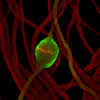Archived Media
| January 31, 2006
For insect cells, like mouse cells, one protein decides between life and death Cells are given life by mitochondria, an organelle that provides them with all the energy they need. But while mitochondria giveth, they also taketh away " when a cell's time is up, they release molecules that start a cascade ending in death. At least that's how it works in humans, mice and other vertebrates. And now, new research from Rockefeller University's Hermann Steller shows for the first time that the molecules and events that trigger cell death in invertebrates can also start in the mitochondria. Read more |
![]()
 |
Aug. 26, 2005
Timing, as the saying goes, is everything. |
![]()
| Mar. 21, 2005
Mice with defective sperm offer clues to infertility in men For 40 percent of the estimated six million American couples battling infertility, the problem lies with the man. But help may be on the way. |
![]()
| Nov. 19, 2004
Hermann Steller is fascinated by death. Death of cells, that is. He has dedicated his research to understanding cell suicide, has dubbed proteins that he has discovered Grim and Reaper, and speaks passionately about "undead" cells that should die, but fail to follow through with their own demise. Read more. |
![]()
 |
May 19, 2003
Sperm cells shaped by natural cell suicide mechanism In male fruit flies, fertility requires it; Trigger for release of "beastly caspases" also identified. |
![]()
|
June 7, 2002 Researchers Solve Killer Protein's "Crime" A killer protein named Reaper. A protective protein in bits and pieces. And a dead cell. This is the scene of one of the body's most perfect crimes: programmed cell death. This vital process occurs throughout life as a means to, among other purposes, eliminate potentially cancerous cells. |
![]()
|
Feb. 1, 2002 A developing cell in the human body sits on the edge of death. Proteins called Grim, Reaper and Hid stand poised, ready to unleash other toxic proteins. Only if a protein messenger from another cell arrives in time to call off the killing, will the cell then mature into any one of the various types of body cells, such as skin, liver and brain. |
